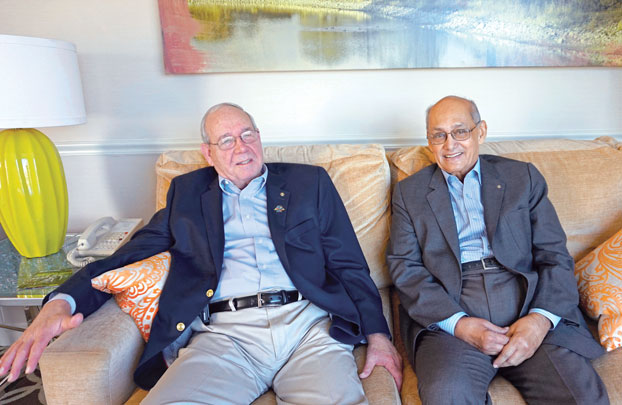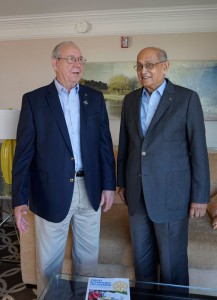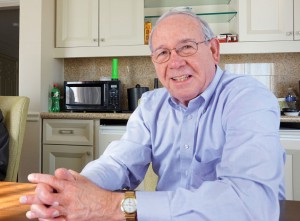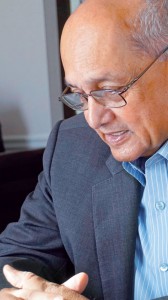Gearing up for TRF Centenary
 TRF Trustee Chair Ray Klinginsmith (RK) and incoming Chair Kalyan Banerjee (KB) are gung ho about the direction and long-term vision of the Foundation. But they also acknowledge the need for change. In an interview to Rotary News after a successful two-day joint session with the RI Board in Evanston, they answered questions ranging from the basics to the plans for the coming Centennial, and demystified how TRF works. Excerpts:
TRF Trustee Chair Ray Klinginsmith (RK) and incoming Chair Kalyan Banerjee (KB) are gung ho about the direction and long-term vision of the Foundation. But they also acknowledge the need for change. In an interview to Rotary News after a successful two-day joint session with the RI Board in Evanston, they answered questions ranging from the basics to the plans for the coming Centennial, and demystified how TRF works. Excerpts:
A brief description please of TRF, its functions and how it is different from the RI Board.
RK: TRF is the charitable arm of the organisation created by RI but made a separate corporation for tax purposes. But though separate it is a parallel organisation with the vision to enable Rotarians to advance world understanding, goodwill and peace. So all our programmes are really peace programmes, and it has been highly successful. We started Rotary scholarships in 1948, in 1965 the group study exchange teams and matching grants. In 1979 came polio immunisation and early 1990 we started the share system by which Districts put in money and three years later get back half of that money, and decide how to use it.
When we did that it became clear Rotarians preferred humanitarian grants projects in favour of scholarships or group exchange study programmes. That gave us a clear indication that we needed to move towards humanitarian projects in developing countries.
What would be the percentage of humanitarian projects and scholarships?
RK: A rough guess — 80:20. The bulk goes to developing countries; there are a few grants in the developed world in pockets, and increasing, but the greatest need is in the developing countries. A third of the world’s population is underserved.
The change in direction came when the matching grants became so popular that in 2000, 35 years after we started, we had done 10,000. But in the next five years we did another 10,000. Due to increased demand, we couldn’t keep up, and the question was do we hire more staff and continue what we are doing or change direction. And thus came Future Vision. I was on the original future visions committee and we decided it was better to give more authority and administrative duties to the districts than increase staff.
But along with this latitude, we insisted that the districts do larger, more sustainable projects. Some grants we gave were of $500, and the cost to administer those were $1,200! That was not good math! So we’re now encouraging clubs and districts to join and do much bigger, more sustainable projects.
How big are the big projects?
RK: The minimum is $30,000, anything over $100,000 is Level 3 and has to come to the Board of Trustees for approval, but there aren’t too many of those in a year.


 $40 million required to upgrade technology
$40 million required to upgrade technology
TRF Trustee Chair Ray Klinginsmith had recommended to the RI Board that Rotarians pay $6 extra every year to finance a more sophisticated technological system to run RI and TRF.
“When you go to amazon.com, their computer system is so sophisticated that not only does your order go through smoothly and quickly, a month later they follow up. We’re still handicapped with old technology. If we ask for extra membership dues, which they’ve decided not to do, of $6 per year for four years, at $7.2 million a year we will get $29 million. The estimated cost of all the improvement we need to make in technology is $40 million.”
He adds it’s “just unbelievable how expensive it is to operate a corporation of this size with a staff of 500. And volunteers all over the world. I’m concerned that every time somebody has a good idea how to improve things, it is put on a list and it will take 3–4 years before it is done.”
Klinginsmith adds there is just not enough money. “They are considering asking for $2–3 extra a year. We are a premier organisation but our business practices currently are not premier.”
Last year there were 1,087 global grants costing $69 million, and roughly Rotary’s contribution was $30 million, which means less than half came from Rotary.
How is the corpus invested, in government bonds, securities, equity? How often is that portfolio churned?
RK: We have professional staff, an investment advisory with senior Rotarians, some of them maintaining investment portfolios for clients, as also a professional manager in a bank in Boston. They advise us on what is new, different. It is a very sophisticated system as we have quite a huge sum.
How huge?
RK: We’ve now hit $1 billion, not all of it is in cash; two thirds is in expectancies — long-term gifts given by our donors. At our recent meeting we approved the concept of increasing that endowment fund corpus to $2 billion by 2025. In other words the cry now is that $2,005 million by 2025!
Is that achievable?
RK: Oh yes, the way we are going.
How has been your year so far as TRF Trustee Chair?
RK: Extremely busy because I’m trying to make some improvements in how we do business. The joint TRF-Board meeting was a change; different because in the past we’ve had occasional joint meetings for a day but never a two-day joint meeting, and never with the kind of agenda we had.
What would you call your biggest achievement so far?
RK: Probably the engagement of the (RI) Board in more strategic matters and decisions than just operational issues. Kalyan (Banerjee) and I are trying to look ahead and plan for the future. Some of what you heard yesterday (at the joint meet) had to do with creation of a strategic plan.
What are you doing for better synergy between the RI Board and TRF?
RK: We’ve made great progress in that and are coordinating our goals; Kalyan is working with John Germ and we have common goals, meetings, and conversations. It is all going to be tied together through this new strategic plan. Previously the strategic planning committee has been only an RI committee. Now we are asking the Council on Legislation to change it towards half and half, which will be a big step forward. The world is changing, no one has any doubts about it, and we have to change.
Mr Banerjee, yesterday at the TRF meet, a Trustee from the print industry talked of change, giving the example of his industry which might be wiped out in 20–25 years. Was he too pessimistic? How do you change and yet retain the core values of Rotary?
KB : It’s not going to be difficult. In my thinking, the problem has been that perhaps in the US, Rotarians have taken a little time to realise that change is inevitable. They have now started the process, and are on the way. It will take a few years before the changes will begin to show. I understand, for example, that last year the membership in US may not have gone down. That is a huge change and it didn’t happen by accident. It happened due to a huge effort. And the realisation by the current Rotarians of America that they have to do something about it. Till now they had either not been paying attention or looking at it in a different way.
As we grow older, we are used to our older friends and we don’t connect with the younger people. And the younger people don’t connect with us … we are a grandfather’s organisation. In India this did not happen for various reasons but we don’t have to go into that. The good news is that it is beginning to happen in America.
One or two things the American Rotarians did right to fix it?
KB: First was the realisation that things are not going well and this is not good for the organisation. It could also have been that the Americans began realising that they were once the premier group in Rotary. A few years ago they were 50 per cent, then they came down to 45 per cent, 40 per cent and now they are below 40 per cent of the membership. And that realisation must have hit them.
RK: Also the realisation by the American clubs that they are not attracting younger members. I attribute part of it to increasing technology. Young people don’t communicate the same way as we did when we were young, and the greater the technological advancements, the greater the gap between the two generations. Many American clubs have realised that we can’t expect the younger generation to change, we will have to change.
KB: Absolutely. I full agree. Because of this the Secretariat itself is beginning to change. The way we operate things is changing, and Ray has played a huge role in getting John Hewko (RI Secretary) on board too.
How does it feel to be taking over as Trustee Chair at such an important moment like the Centenary? A great moment for Indian Rotarians; I believe they are gearing up to raise more funds for the Foundation.
KB: Oh yes, they are very excited. They’ve already said they will give a considerable amount. Last year India raised nearly $15 million.
Coming to the $6 fee Ray talked about (see Box), the first ever contribution by an AKS member was $26.5 in 1917. It is from there we are taking about $26.
RK: That, depending on which formula you use, is deemed to be $535 in today’s buying terms. $26.5 then would have bought you what you can get now for $535.
RID Frederick Lynn from Taiwan is planning to get 5 AKS members from Taiwan, each contributing $1 million. Is that possible in India?
KB: One million may not be possible but we will get many more AKS members.
I’ve been thinking that just like we have AKS ceremonies here in Evanston, where you have a Taiwan Day, or a South Korea Day, when all the AKS members from that country are inducted, we should have these in India. Sometimes all our AKS members are not able to come all the way here.
How many AKS members do we get from India every year?
KB: Nowadays we are beginning to get more; people are beginning to give more. Normally, between 5–10 in a year.
How easy or difficult is it to ask people to give money for humanitarian causes?
KB: It is not difficult; if you ask, people are ready to give money. But very often the problem is that nobody asks. But you should have the courage to ask. It doesn’t matter if they don’t or can’t give, but we have to ask.
RK: And many people are already planning to give to charitable organisations; it is only a question of which organisation to give to.
KB: The only issue in India is that you don’t get the kind of tax benefits that you get in America. And don’t forget $250,000 in Indian money is a lot of money.
So how many Americans are AKS members?
RK: Over 500, and we get 60–70 new ones every year so the US number should be 1,000 in the next six years.
Surely it was a major triumph for Rotary to get Bill and Melinda Gates Foundation on board? Are efforts on to get other such partners?
RK: We have an active and new joint committee on partnerships, with senior Rotarians and a new director with an amazing background in philanthropy work. I think that combination is going to produce another Bill and Melinda Gates Foundation along the way.
What are going to be your priorities for the Centenary year? And what next after polio?
KB: One, raising funds for TRF so that we can do better and more significant work. A time will soon come, at least we think so, when polio will be over. And whether we agree or not, Rotarians are beginning to think that way. And in India they are looking at other things; literacy, water management, toilets in schools are big things today. Literacy in India, believe me, is a bigger thing than polio. Polio is one aspect, a small aspect, but literacy encompassed the whole human scenario, it’s a major thing. In a way we’ve sharpened our tools and brightened our vision through polio which has equipped us to think of new things such as literacy.
I remember Muhammad Yunus asking us at one Rotary meeting: What great work will you take up after polio is done? He said the only thing that deserves your great capabilities and engagement power is the removal of poverty itself. And I thought, my God, what is he talking about?
But when somebody like Yunus talks and thinks like that … I don’t know whether he said it only to please us …. It’s something very special, it’s different. So whether it is literacy or food … hunger is a huge issue in some parts of the world today, along with water, we really don’t know. I doubt Rotary will go towards another medical problem. We don’t want to be known as an organisation confined only to medical issues. So when you ask what next, we don’t know, let’s see.
When the world talks about polio — whether it’s a coffee table book, or media reports, I find little mention of Rotary, compared to the huge work all of you have done.
KB: I think it’s beginning to happen now. Even though we were engaged in it passionately, we expected recognition a little too early. But now the recognition is beginning to come. But we must also remember that it is not only Rotary which is doing the polio eradication work. It is WHO and the Government of India who are immunising children. But the idea was Rotary’s in the first place, not that of the Indian or any other Government or WHO. We engaged WHO in this work and UNICEF came much later.
Any big bang projects planned for Centenary year?
KB: Not really TRF has six areas of focus and we’d like to focus on all of them. We are working hard in areas of peace; we give peace scholarships. We have started something that is important. Our peace programmes have not perhaps delivered as much as we had hoped. And maybe we need some fix, some changes, in the way we are looking at peace. But when there are peace issues anywhere in the world, they don’t look for Rotary in the first place. We are not there to help in any way….
But you are not equipped to; there is so much strife and conflict and violence in the world today.
KB: I know. But my point is, are we getting any closer to world peace because of our efforts or anything that we are doing? And if not, what do we need to do, to bring about a change.
RK: We started the peace programmes in 2002, 13 years ago … certificate programmes, all of which have been in place for 10 years without change. So my concern is, are we keeping up with the changing world? The conflicts have changed. The methods of teaching have changed. Are we still on the cutting edge or have we fallen behind is the primary question.
I was disappointed that there isn’t a single Female Trustee in TRF. Why is this so?
RK: I wish I knew the answer. But we’ve had women in the past. The President-elect nominates people around the world to serve on TRF, and it has to get the approval of the Board of Directors. We look for geographic distribution and experience in various professions … lawyers, doctors, etc. And in the last two years a woman hasn’t cropped up. It’s a little embarrassing though.
Well, RI is yet to get a woman President and so is the United States!
RK: In my committees at least I try to have women wherever possible.
KB: That way, we in India are a little different. We’ve had a woman president, woman prime minister.
How would you say Rotary has changed India and India has changed Rotary?
KB: We often say that thanks to Polio-Plus, the world discovered Rotary, and Rotarians discovered themselves!
Pictures by Rasheeda Bhagat
